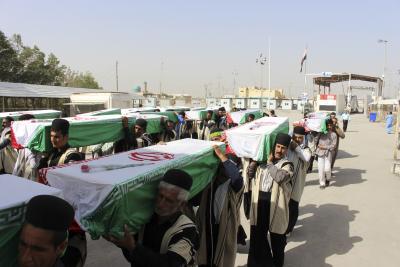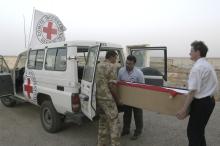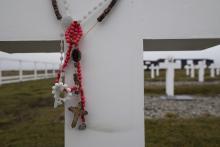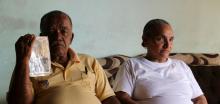Case prepared by Clara Delarue, Ana-Paula Ilg, Claudia Langianese, Eleanor Umeyor, LL.M. students at Roma Tre University under the supervision of Giulio Bartolini (IHL Professor), Tommaso Natoli and Alice Riccardi (Research assistants), Roma Tre University IHL Legal Clinic.
A. SIGNATURE OF A MEMORANDUM OF UNDERSTANDING AND TRAINING OF THE MEDICAL PESONNEL TO FORENSIC METHODS OF IDENTIFICATION
Iran and Iraq
In October 2008, Iran, Iraq and the International Committee of the Red Cross (ICRC) signed a comprehensive Memorandum of Understanding to investigate the fate of the hundreds of thousands of cases of disappeared and missing persons from the Iran–Iraq War in the 1980s. In that context, EAAF [Argentine Forensic Anthropology Team] was invited by the ICRC to provide a forensic training course in Tehran in November 2008 and in Baghdad in March 2009.
[…]
The document represents an important step in the search for people unaccounted for twenty years after the end of the war and “establishes a clear framework for collecting information [about missing persons] and sharing it between the two countries, and for handing over mortal remains. These tasks will be performed jointly by experts from both countries with ICRC support.”
In November 2008, in the presence of ICRC delegates, remains of approximately 250 Iraqi and Iranian soldiers were exchanged near Basra and were handed over to the responsible authorities on each side. Before 2008, the two countries have sporadically exchanged across the border remains of disappeared or missing persons related to the war.
[…]
EAAF Participation
The ICRC invited an EAAF member as a speaker and external consultant to participate in a course on “Advances on Identification of Human Remains: Forensic Anthropology and Archaeology”. Taking place from November 9 to 11, 2008 in Tehran, the training was arranged at the request of Iranian authorities and was jointly organized by the ICRC and the governmental Legal Medical Organization (LMO), Tehran. The training was attended by local medical personnel, geneticists and members of LMO, and the governmental Kawsar Research Center for Missing Martyrs and governmental Committee for Search and Recovery of Mortal Remains. The course focused on capacity building in the areas of forensic anthropology and genetics.
The three-day course was held within the framework of ICRC’s humanitarian work to support ongoing efforts to shed light on the fate of persons disappeared during the Iran-Iraq war. The application of forensic sciences is fundamental to those efforts.
An EAAF member also took part as a speaker and external consultant for a training program held in Baghdad in March 2009. The program was designed for public officials from the Ministry of Human Rights, which is the agency that is overseeing efforts to investigate these cases, and associated forensic experts at the Medico-Legal Institute.
Based on the interest of participants, the course was geared towards the identification of remains as a major challenge, especially after the Iran-Iraq War, the Gulf War, or the combat since 2003. A practical course with representatives from both countries has also been planned, but no date has yet been set. Both countries though have expressed interest in coordinating the identification and return of remains from the Iran-Iraq War. At the end of the training workshops, participants expressed strong interest in receiving support and further training and recognized the need to standardize practices and establish protocols for forensic work.
B. IRAQ, IRAN, SWAP REMAINS OF 1980-1988 WAR DEAD
Iraq and Iran on Sunday exchanged the remains of 241 soldiers killed during an eight-year war between the two countries – the latest sign of increased cooperation between the neighbouring nations that were fierce rivals under Saddam Hussein.
It was the first such handover since the two sides signed an agreement in October to work together in tracing tens of thousands still missing after the war.
The Iraqis and the Iranians have previously exchanged remains and prisoners of war, but Sunday's pomp-filled ceremony raised hope that the agreement could lead to closure for the relatives of those killed or missing on both sides.
"We hope that this tragedy ends as soon as possible and this file is closed forever ... so that the families can have some rest after learning the fate and the whereabouts of their loved ones," said Mahdi al-Tamimi, an official in Iraq's Human Rights Ministry.
The remains of 200 Iraqis and 41 Iranians were returned to their native countries at the Shalamcha border crossing near the southern Iraqi city of Basra. Only 23 of the Iraqi and 10 of the Iranian remains have been identified, according to the International Committee of the Red Cross, which oversaw the handover.
Mourners threw roses on the flag-covered wooden coffins, crying and beating their chests as the remains were borne by Iraqi soldiers and Iranian sailors to the border from both sides. Women shrouded in black Islamic robes wept as a brass band played for the procession.
More than 1 million people from both sides were killed or went missing during the 1980-1988 war.
Iraq and Iran agreed in mid-October to work together to gather and share information about the missing and to hand over any remains uncovered. It was the first direct agreement to tackle the problem together. Previously, each side dealt separately with the Red Cross.
"The return of the bodies is important for the families of the dead and an essential element in the process of dealing with the past," said Jamila Hammami, an ICRC delegate in charge of the missing persons file for Iraq.
Hammami, who was at the handover ceremony, said many of the families never lost hope.
Hopeful relatives with missing loved ones attended the ceremony, but officials said nobody on the Iraqi side claimed any of the returned bodies.
[…]
Relations between Iraq and Iran have dramatically improved after Saddam's 2003 ouster, which led to the empowerment of Iraq's majority Shiites after decades of oppression at the hands of the Sunni Arab minority, to which the late Saddam belonged.
[…]
C. IRAN/IRAQ: SOLDIERS’ REMAINS RETURNED TO FAMILIES
Baghdad/Tehran (ICRC) - The ICRC has once again participated in the handover of the remains of soldiers killed during the Iran-Iraq war.
The remains were repatriated to their respective countries on 22 January 2015 during a ceremony at the Shalamcha border crossing near Basra (Iraq), attended by military and civilian officials from both countries in the presence of ICRC staff. Of the remains repatriated during this ceremony, forensic teams have so far identified 46 of the Iranian soldiers and 3 of the Iraqi personnel. Work continues on identifying the others.
"Over 25 years have passed since the guns fell silent, yet thousands of families on both sides still don't know what happened to their loved ones," said Patrick Youssef, who heads the ICRC delegation in Iraq. "It is vital that families know the fate of their missing sons if they are to reach any kind of closure and deal with their pain."
The ICRC is currently assessing the needs of families of missing persons in Iraq to see what help they require.
"We applaud the steps already taken jointly to recover human remains from the Iran-Iraq war," said Olivier Martin, who heads the ICRC's mission in Iran. "In particular, today's ceremony is only possible thanks to the cooperation and determination of the Iranian and Iraqi governments."
Under international humanitarian law, families have a right to know the fate of their missing relatives. The two sides have shown commitment to ensure that this right is respected.
[…]
Discussion
I. Classification of the Situation and Applicable Law
1. How would you classify the situation between Iraq and Iran during 1980-1988? What additional information would you need in order to make such a determination? (
CG I-IV, Art. 2)
II. Treatment of Missing and Dead Persons
2. What are the obligations of the parties to the conflict with respect to missing persons and their next-of-kin?
b. When persons are reported missing what steps should parties to the conflict take to clarify the fate of such persons? What does IHL say about ‘the right to know’? (
P I, Art. 33)
3. What are the obligations of parties to an international armed conflict with regards to the dead? How do these obligations relate to the duty to clarify the fate of missing persons? Are the parties to the conflicts obliged under IHL to return the remains of the dead to their family members? Are the relevant rules also applicable in non-international armed conflicts? (
GC I, Arts 15,
16,
17; GC IV, Arts.
16,
129,
130,
131;
P I, Art. 34;
P II, Art. 8; CIHL, Rules
112,
113,
114,
115,
116)
5. What is the legal value of the Memorandum of Understanding signed among Iraq, Iran and the ICRC? How did this document helped to establish a cooperation between the two belligerent parties? What role is played by the ICRC in that regard?
III. Elements contributing to Respect for IHL
6.(Document A) How did the Argentine Forensic Anthropology Team help in the identification of mortal remains in Iraq? Why is cooperation and sharing of best practices between countries facing similar situations so important to ensure better compliance with IHL?
7. How can technological and medical innovations support the fulfilment of IHL obligations?
8. (Documents B, C) Why is respect for the families' "right to know" important to facilitate the return to peace once hostilities have ceased?
9. (Documents A, B and C) In what ways does the ICRC work to support ongoing efforts to "shed light on the fate of persons disappeared during the Iraq-Iran war"? What about other NGOs? Are the Iraqi and Iranian governments also involved in such activities? In what ways? How do you explain that the agreement between Iraq and Iran was the first ever direct agreement between the two countries?






